From the ancient seat of the Celtic High Kings to the Mountain of the Witch; from the Celtic severed-head ritual to the warrior Queen Maeve’s tomb, there are countless Irish mystical sites waiting to be explored, all of which have tales of pagan Celtic warriors, fairies, and magic.
Here, we take you through a tour of some of Ireland’s most magical mythological sites:
Stop 1: The Boyne Valley: Newgrange, Knowth, Dowth, Hill of Tara & Hill of Slane, Co Meath
Brú na Bóinne (the Boyne Palace) spreads over Counties Meath and Louth. The Boyne Palace contains some of the most important historic sites and monuments in Ireland, including the massive, ancient passage tombs of Newgrange, Knowth and Dowth, the pagan headquarters of the Hill of Tara and the legendary Hill of Slane.
Newgrange
Newgrange is Ireland's most famous prehistoric site. As with most passage tombs in Ireland, archeologists believe it was built around 3200 B.C., making Newgrange older than Stonehenge in England and the Pyramids in Egypt.
Newgrange was built so that during the winter solstice (dawn on the shortest day of the year), a narrow beam of sunlight illuminates the floor of the chamber at the end of the long passageway for about 17 minutes.
The Celtic myth says that Newgrange is a fairy mound or a sidh. A group of ancient people, the Tuatha Dé Danann, or “people of the goddess Danu,” dwelled there. Newgrange was built by the god Dagda and named for the goddess Boann.
Some say that the famous Irish mythological hero Cuchulainn was conceived in Newgrange.
Access to Newgrange begins at a visitors' center, from where you can take a guided tour of the site. The center hosts a re-enactment of the winter solstice at Newgrange using electric lights installed within the tomb. A lottery is held annually for tickets to enter the tomb during the actual event.
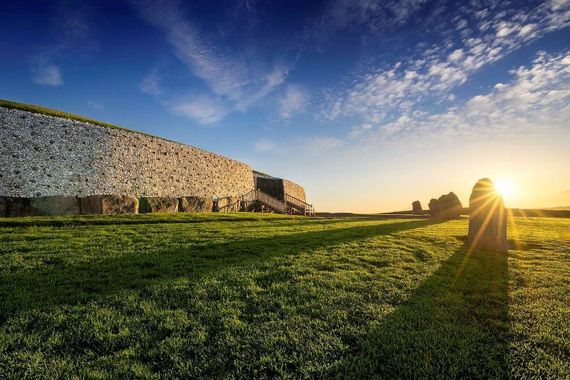
Newgrange.
Knowth
The Great Mound at Knowth is the second of the three major passage tombs in the Boyne Valley. Built over 5,000 years ago, the mound is younger than Newgrange but older than Dowth. Knowth is about the same size as Newgrange.
The mound has two passages (unlike Newgrange, which has one), with entrances on the east and west sides. Recent scientific data suggests that Knowth had a lunar function in ancient rituals.
Knowth is best known for its impressively large collection of stones carved with Neolithic art, which comprises a quarter of all known Neolithic art in Europe.
It is said that a noblewoman named Bua is buried at Knowth, and a “great hill” was built up over her, creating the Great Mound at Knowth.
You can access the Knowth site through a guided tour from the Brú na Bóinne Center.
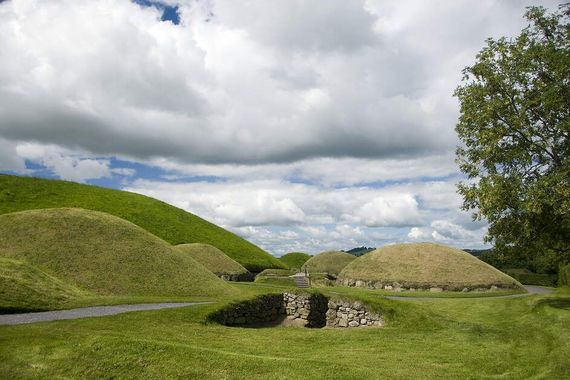
Knowth.
Dowth
The third passage tomb site in the Boyne Valley is Dowth, or the “Fairy Mound of Darkness” (sounds appealing, eh?). It is similar in size to Newgrange and Knowth, and like the two complexes, was built 5,000 years ago.
The Dowth mound has two small passages, both located on the western side. Like Newgrange, the southernmost passage at Dowth is aligned with the setting sun at the winter solstice.
Dowth is not included in the Brú na Bóinne Visitors Center tour, and you cannot enter inside the tomb, but you can directly access it (it’s a short way from the Slane to Drogheda road) and meander around the peaceful site.
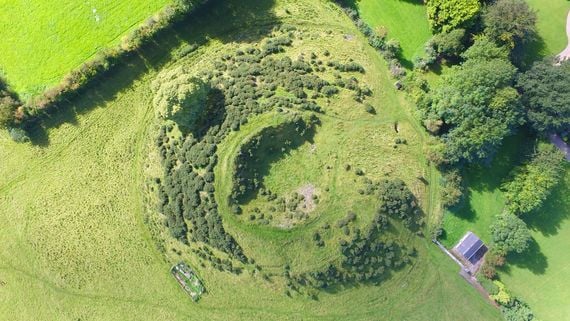
Dowth.
Hill of Tara
The Hill of Tara, also in the Boyne Valley, is the ancient seat of power in Ireland and contains over 30 visible ancient monuments, including the Stone of Destiny and the Mound of the Hostages.
The Hill is said to be the actual seat of the High Kings of Celtic Ireland and the sacred dwelling place of the gods.
It is believed that St. Patrick went to Tara—the most powerful Celtic pagan site—to confront the religion of the Celts.
One of the most famous monuments at Tara, the Stone of Destiny, is known as the Lia Fáil. The stone, believed to be a symbol of fertility, once stood in front of the passage tomb at Tara, the Mound of the Hostages. The High King legend says the Stone of Destiny would sing and roar in praise if it approved the inauguration of a worthy High King.
The megalithic passage tomb at Tara, the Mound of the Hostages, is the oldest monument of the site. Evidence of at least 200 individual cremations has been uncovered at the mound.
Engravings within the tomb are thought to represent the sun, moon, or stars as religious symbols, and one of the stones may have been used as a prehistoric calendar.
Access to the Hill of Tara is free, but if you want a bit more background on the site, take a guided tour at the visitor center.
Tara is now under threat due to the construction of the M3 highway. Protestors are hard at work to save Tara: the Hill of Tara was included in the World’s Monument Fund 2008 Watch List of the 100 Most Endangered Sites in the world, and there is a letter-writing campaign in the works in order to preserve the site.
 13
13
Hill of Tara.
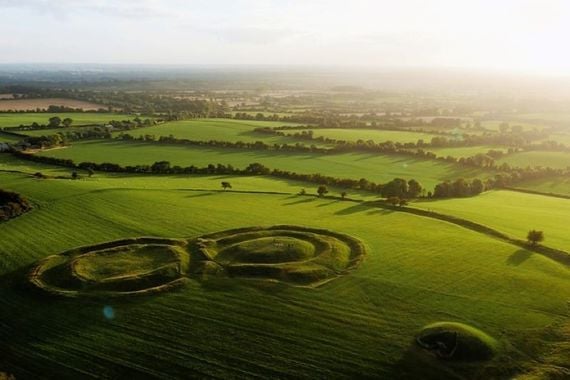
Hill of Tara.
Hill Of Slane
According to myth, the impressive Hill of Slane is the burial place of King Sláine, the king of the Fir Bolg (an ancient people of Ireland).
In more recent Christian history, the hill is also the site where Patrick lit the divine Paschal Fire in defiance of the pagan kings at Tara. Church ruins lie atop the hill, and the site remains a popular destination for Christians.
The Hill of Slane is accessible at all times, and there is no entry fee.
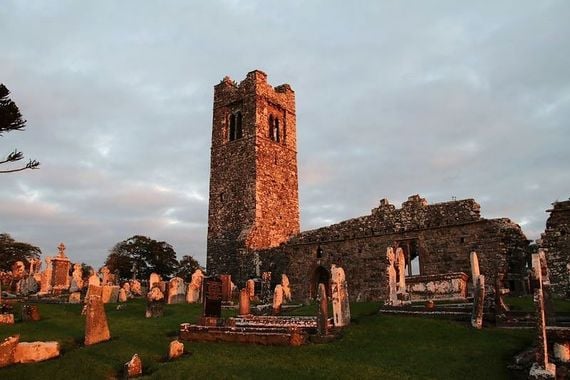
Hill Of Slane.
Stop 2: Loughcrew Oldcastle, Co Meath
Loughcrew, also called “The Storied Hills” or “Mountain of the Witch,” is one of Ireland’s major passage tomb sites (the others are Bru na Boinne, Carrowkeel, and Carrowmore), all believed to date back to around 3200 B.C. The site is composed of clusters of cairns (man-made, pyramid-like stone piles) around hills.
The winter solstice at Newgrange is well known, but the lesser-known Equinox illumination at sunrise occurs at Loughcrew. The backstone of the chamber is illuminated by a beam of light at sunrise on the Spring and autumn equinoxes.
The myth says that the monuments of Loughcrew were created by a witch flying overhead who dropped large stones from her apron.
Admission to the site is free, but be aware that the climb to Loughcrew is quite steep.
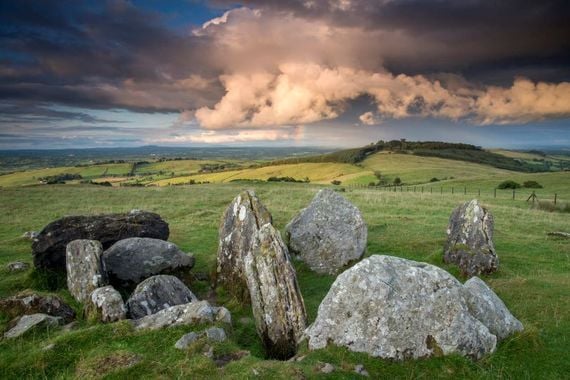
Loughcrew cairns, Co. Meath
Stop 3: Navan Fort & The King’s Stables, Armagh, Co. Armagh
Navan Fort is a historical royal fortress on Killylea Road in Co. Armagh. The ancient monument was a stronghold of the kings of Ulster around 700 B.C. The Fort was the center of King Conchobor mac Nessa and his Red Branch Knights.
Navan Fort is surrounded by a bank with a ditch inside, suggesting it was a ceremonial rather than defensive site.
It is said that the great Irish mythical hero Cuchulainn spent much of his youth in Navan Fort before single-handedly facing the army of the mythical Queen Maeve.
The Fort was eventually abandoned, probably due to the creation of St. Patrick’s Church two miles away. But in 1005, the Irish king Brian Boru camped there, and in 1387, Niall O’Neill chose Navan Fort as the location for a house.
One mile west of Navan Fort lies another myth site, the mysterious King’s Stables, which is thought to have played a role in local water rituals.
King's Stables, which was built around 1000 B.C, is a 10-foot-deep man-made pool surrounded by a bank. It is believed that its significance lies in water, as the prehistoric Celts are known to have practiced water cult ceremonies.
A brief excavation of the site in 1975 uncovered the front of a human skull that was severed from the back part, perhaps related to another famous Celtic cult ritual – the severed head, a large-scale beheading as human sacrifice to the Celtic gods.
You can take a tour of the sites through the Navan Center.
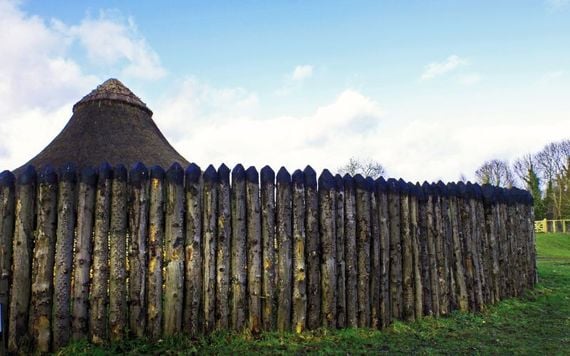
Navan Fort. (Getty Images)
Stop 4: Beaghmore Stones, Cookstown, Co Tyrone
Stone circles in Ireland span across the Sperrins Mountains in Counties Tyrone, Derry, and Fermanagh. In each area, there is a concentration of sites comprising multiple stone circles. The circles have relatively small diameters and are composed of about 40 stones each.
The circles are typically misshapen and occur in pairs or multiples at a single location.
Tyrone has the most stone circles; there are 61 known rings there. The most famous stone circle complex is at Beaghmore (“the moor of the birches”) in Co Tyrone. The complex was accidentally uncovered in the 1940s while men were peat cutting. It took four years of excavation to remove a thick layer of protective peat and to expose the 1,269 stones of the seven-circle complex.
Thus far, seven stone circles, 13 cairns, and several rows of standing stones that make up the Beaghmore complex have been uncovered, but it is assumed that even more are still hidden in the surrounding peat.
It is believed that the stone circles date back to 1600 B.C., but field walls, fireplaces, and flint tools discovered at the site suggest that it was in use since 2900 B.C.
It seems the builders of the complex intended to align the stone rows with the midwinter sunset, so some archaeologists believe the circles were constructed to record the movements of the sun and moon and mark lunar and solar events.
Alternatively, the stone rows are thought by many to have been used for ancient rituals, either religious or social.
The Beaghmore Stones lie 10 miles west of Cookstown, and can be accessed for free at any time.
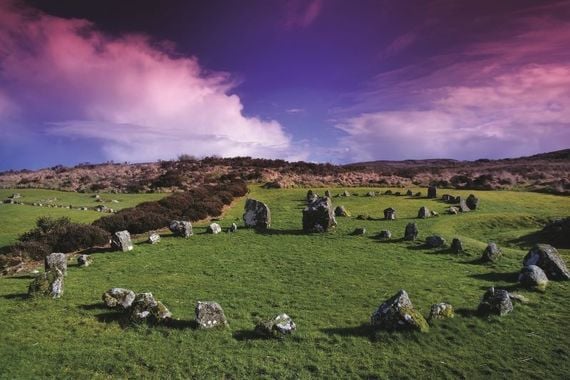
Beaghmore Stone Circles. (Ireland's Content Pool)
Stop 5: Grianan Ailigh, Letterkenny, Co Donegal
An Grianan Ailigh is a mysterious circular stone fort which is thought to date back to 1700 B.C. The fort sits on the hill of Grianan, 750 feet above sea level, so the views from the surrounding Donegal countryside are amazing.
According to myth, the fort was built 4,000 years ago by the god of the people, the Tuatha Dé Danann, to house the grave of his son. The fort then became the seat of the Kingdom of Ailigh, and was a center of culture and politics during the rule of early Irish chieftains.
The road that leads to Grianan Ailigh can be accessed from the main Letterkenny to Derry road.
 13
13
Grianan Ailigh Letterkenny, Co. Donegal

Grianan Ailigh Letterkenny, Co. Donegal
Stop 6: Carrowmore and Carrowkeel Co. Sligo
Carrowmore & Carrowkeel are two megalithic sites in Co. Sligo and once held over 200 tombs.
The two sites are joined by the Uinshin river, which flows from Lough Arrow to Ballisodare Bay – the main road during the Stone Age. This makes the Carrowmore/Carrowkeel area one of the most important centers of ancient mythological Ireland.
The monuments' location, along with their breadth and majesty, underscores the area's significance and the ancient Celtic people’s reverence for the dead.
Carrowmore
The most extensive megalithic complex in Ireland, about 30 tombs can be viewed at the sacred lands of Carrowmore (though it is thought that up to 100 existed at one time).
The tombs are mostly “dolmen” circles, or a single tomb made of three or so upright stones supporting a large, flat, horizontal stone, surrounded by a circle of boulders. There is an average of 30-35 stones in each boulder circle, set side by side. Most circles are around 40 feet in diameter, but a few span up to 165 feet.
Carrowmore is classified alongside Newgrange and Loughcrew as part of the Irish Passage Tomb Tradition.
Within Carrowmore lies the Great Cairn of Knocknarea – also known as Queen Maeve’s Tomb.
The monument, 197 feet in diameter, was built about 6,000 years ago and is situated on the highest part of the flat top of Knocknarea mountain, 327 meters above sea level.
The cairn is one of the most impressive and well-preserved ancient monuments in all of Ireland, and stands in one of the most beautiful and visible locations of any passage tomb.
According to legend, the site is the resting place of Queen Maeve of Connaught in the Ulster Cycle of Irish mythology, and an iconic Irish mythological warrior (which may help explain why her tomb is so well preserved).
Queen Maeve is notorious for inciting the Tain Bo Culainge (“The Cattle Raid of Cooley”), where she led her province to war against Ulster to steal their prized bull.
Maeve’s choice to be buried on Knocknarea speaks volumes about its importance in Irish mythological history.

Carrowmore, Co. Sligo
Carrowkeel
Carrowkeel, which lies atop the Bricklieve Mountains, is a collection of some of the most mysterious mounds in all of Ireland. It is a lesser-known ancient site than Carrowmore, but it is equally significant in Ireland’s mythical past and has one of the most beautiful locations among megalithic sites. Carrowkeel is the fourth major passage tomb cemetery in Ireland (the others being Newgrange, Loughcrew, and Carrowmore).
Today, 14 passage tombs can be seen at Carrowkeel. One of the tombs is a “classic” Irish passage tomb – one with a short passage you can crawl through that leads to a central chamber with three equally spaced side chambers. What’s unique about the tomb is the roofbox above the entrance. The only other known roofbox is at Newgrange, but while Newgrange is aligned to the Winter solstice, the Carrowkeel roofbox is aligned to the midsummer sunset, suggesting two distinct ritual sites.
Both Carrowmore and Carrowkeel are very accessible from main roads in South Sligo.
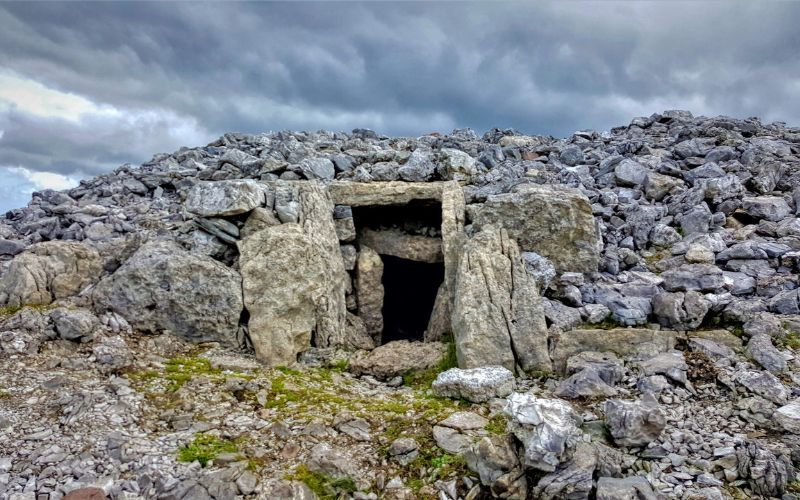
Carrowkeel, Co Sligo. (Ireland's Content Pool)
Stop 7: The Rock of Cashel, Co Tipperary
Legend has it that the Devil took a bit out of a side of a mountain in North Tipperary – now known as the Devil’s Bit – and then spat out a rock, which landed at Cashel. That rock is now known as the Rock of Cashel.
The Rock was the traditional seat of the High Kings of Munster prior to the Norman invasion.
Numerous buildings are perched on the site, the majority of which date back to the 12th and 13th centuries, and today hold some of the most extraordinary collections of Celtic art in Europe.
The Rock of Cashel is also known as St. Patrick’s Rock because Cashel is the presumed site of St. Patrick's conversion of the King of Munster in the 5th century.
The site has a small admission fee, and guided tours are available upon request.
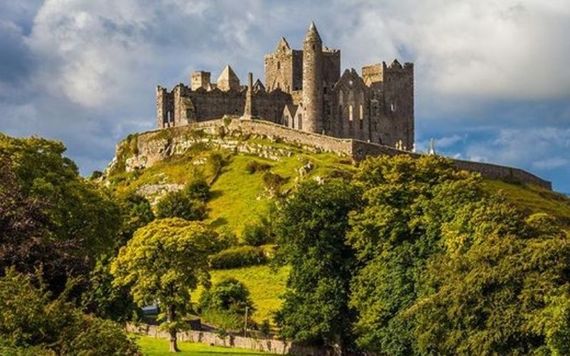
The Rock of Cashel Cashel, Co. Tipperary
* Originally published in 2010, updated in Oct 2025.
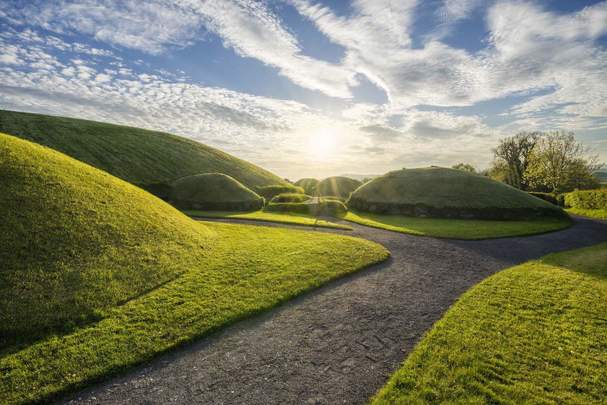
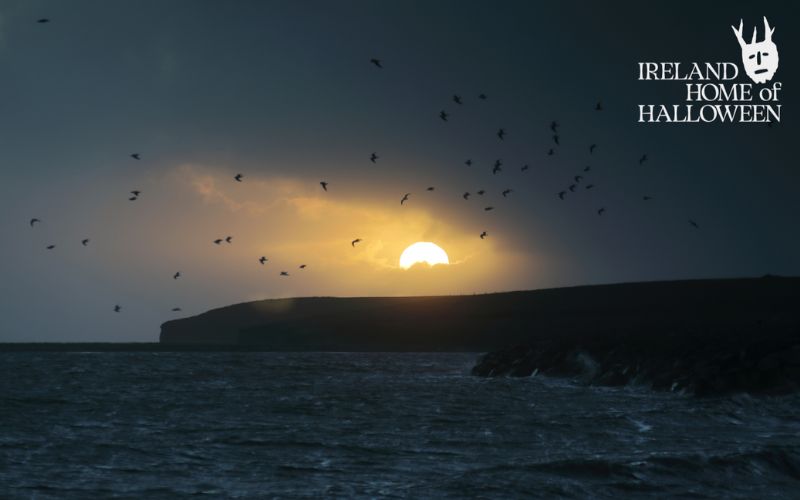
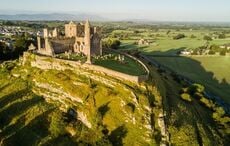

Comments